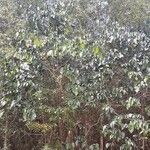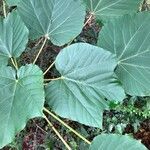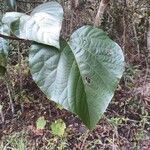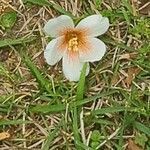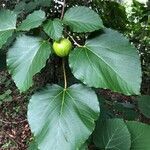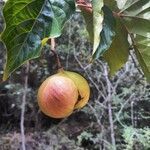Trees deciduous, up to 10 m tall, monoecious; bark gray, nearly smooth; branches verticillate, stout, glabrous, prominently lenticellate. Petiole as long as leaf blade, glabrescent, with 2 compressed and sessile glands; leaf blade ovate, 5-18 × 3-15 cm, puberulent when young, dark green and glabrous adaxially, gray-green and pubescent abaxially at maturity, base truncate to shallowly cordate, margin entire, rarely shallowly 1-3-fid, apex acute; palmate veins 5(-7). Inflorescences flat-topped panicles of cymes, appearing generally before new leaves, usually bisexual; calyx ca. 10 mm, 2(or 3)-fid, densely brown puberulent outside; petals obovate, 2-3 × 1-1.5 cm, yellow at base, pink to purplish, pink-veined, base clawed, apex rounded; stamens 8-12; outer filaments free, inner filaments connate to below middle; ovary 3-5(-8)-locular, pubescent; styles 3-5(-8), bifid. Drupe subglobose, 4-6(-8) cm in diam.; exocarp smooth, not grooved, 3-or 4(-8)-seeded. Seed coat woody. Fl. Mar-Apr, fr. Aug-Nov.
Trees, to 10[–20] m. Leaves: stipules 4–12 mm; petiole 6–22 cm, with pair of round, sessile, cushion-shaped glands at apex; blade broadly ovate or triangular-ovate, 10–25 × 8–20 cm, usually unlobed, sometimes shallowly 3-lobed, base cordate, truncate, or rounded, apex acuminate, both surfaces moderately to sparsely hairy, hairs appressed. Inflorescences 6–15 × 6–20 cm, often branching from near base, branches to 15 cm. Pedicels 1–2 cm. Staminate flowers: sepals green to purplish, 10–12 mm; petals white or pale pink with dark pink to red veins proximally, sometimes yellow basally, obovate, 25–35(–40) × 15–20 mm, narrowed at base; nectary glands awl-shaped to strap-shaped; stamens in outer whorl 8 mm, in inner whorl 13 mm, connate 1/2–2/3 length. Pistillate flowers: sepals and petals as in staminate flowers; ovary hairy. Capsules subglobose, 4–6 cm diam., smooth, glabrous or glabrate, short stipitate, apex apiculate. Seeds 2.5–3 × 2 cm, surface warty, ridged. 2n = 22 (China).
Tree to 10 m high. Stipules lanceolate, 6–9 mm long. Leaves: Petiole 4–14 cm long; lamina broadly ovate, often trilobed when juvenile, 6–35 cm long, 4.5–30 cm wide; base cordate to lobate; tip acuminate. Inflorescence up to 12 cm long. Male flowers 20–25 mm long, 35–40 mm diam.; pedicels 10–16 mm long; stamens 8–10. Female flowers 20–25 mm long, 35–40 mm diam.; pedicels 10–16 mm long. Fruit ± spherical, 4–5 cm long, 3.5–5 cm diam. Seeds 20–25 mm long, 20–22 mm diam.
An evergreen tree which grows to 7 m high. It spreads to 3 m across. The stem is erect and stout. The leaves are light green and heart shaped. They have 3 lobes and are pointed at the tip. Leaves are 25 cm long and are often arranged in whorls or layers. The flowers occur in long sprays and are pink. These flower sprays are 10-15 cm long. The fruit are thick shelled nuts. They are round and greenish brown. Fruit are 6-7 cm across.
Very like V. montana, but differing in having an appressed golden-sericeous indumentum, sessile discoid glands at the base of the leaf blade, usually bisexual inflorescences, precocious flowers, larger petals (c. 3 cm long), a sparingly-pubescent ovary and smooth or faintly lineate ± spherical fruits.
